Report on Procurement: Spencer Street Station Redevelopment Project
VerifiedAdded on 2020/05/28
|15
|4393
|182
Report
AI Summary
This report critically analyzes the procurement approach used in the construction project of the Spencer Street Station, also known as Southern Cross Station. It details the Public-Private Partnership (PPP) method employed by the Southern Cross Station Authority, highlighting its advantages, such as cost savings and faster delivery, and disadvantages, including contractual disputes. The report suggests relational contracting as a more suitable procurement approach. It explores the characteristics of PPP, including financing, maintenance, and risk allocation, and discusses the roles of various stakeholders. The analysis covers strategic project alliances, the consortium concession period, and the project's financial aspects, including the AUD$700 million investment. The report emphasizes the importance of efficient risk management and the private sector's expertise in delivering public services. The report also discusses the four pillars of relational contracting, emphasizing the importance of cooperation and trust among stakeholders.
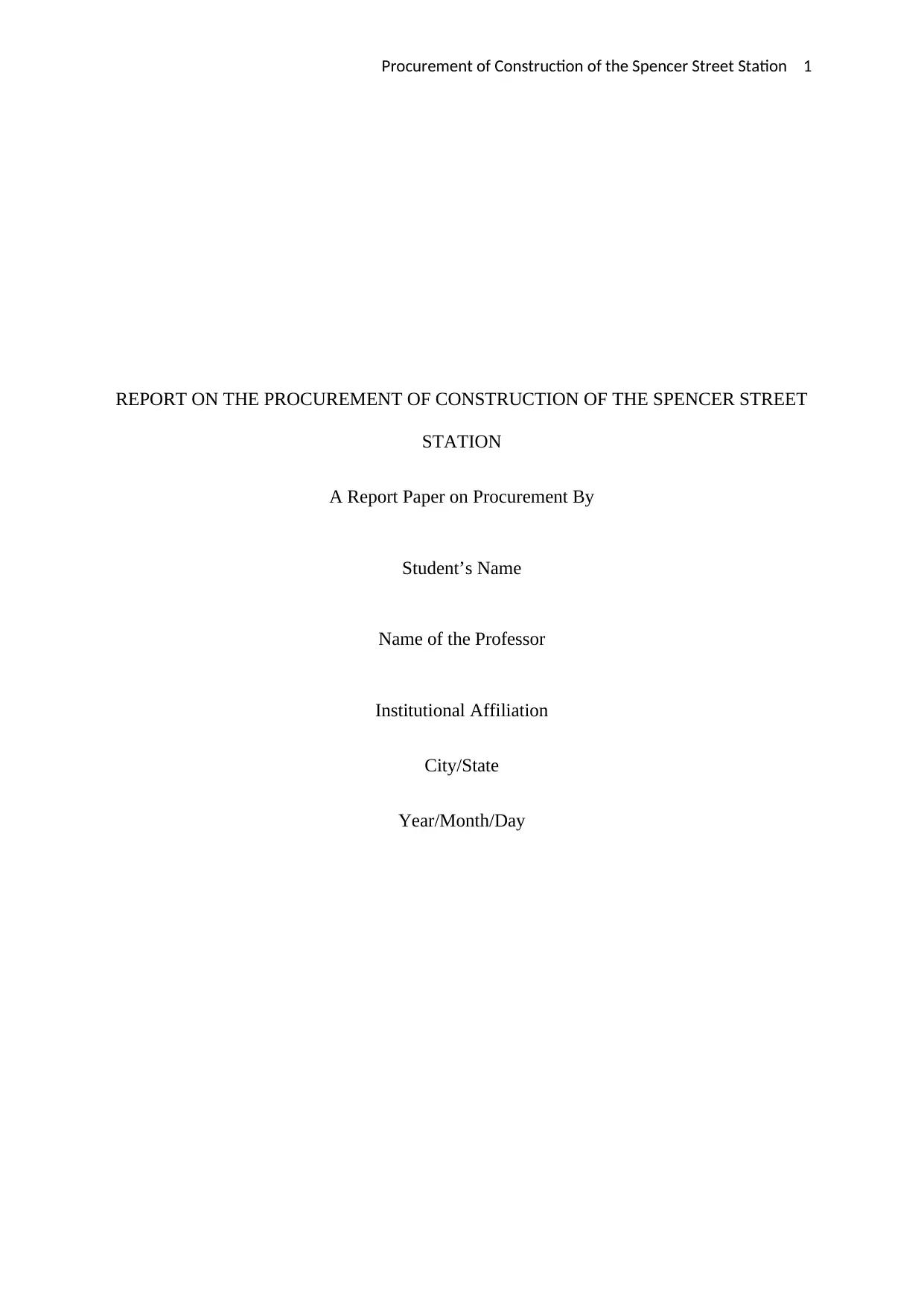
Procurement of Construction of the Spencer Street Station 1
REPORT ON THE PROCUREMENT OF CONSTRUCTION OF THE SPENCER STREET
STATION
A Report Paper on Procurement By
Student’s Name
Name of the Professor
Institutional Affiliation
City/State
Year/Month/Day
REPORT ON THE PROCUREMENT OF CONSTRUCTION OF THE SPENCER STREET
STATION
A Report Paper on Procurement By
Student’s Name
Name of the Professor
Institutional Affiliation
City/State
Year/Month/Day
Paraphrase This Document
Need a fresh take? Get an instant paraphrase of this document with our AI Paraphraser
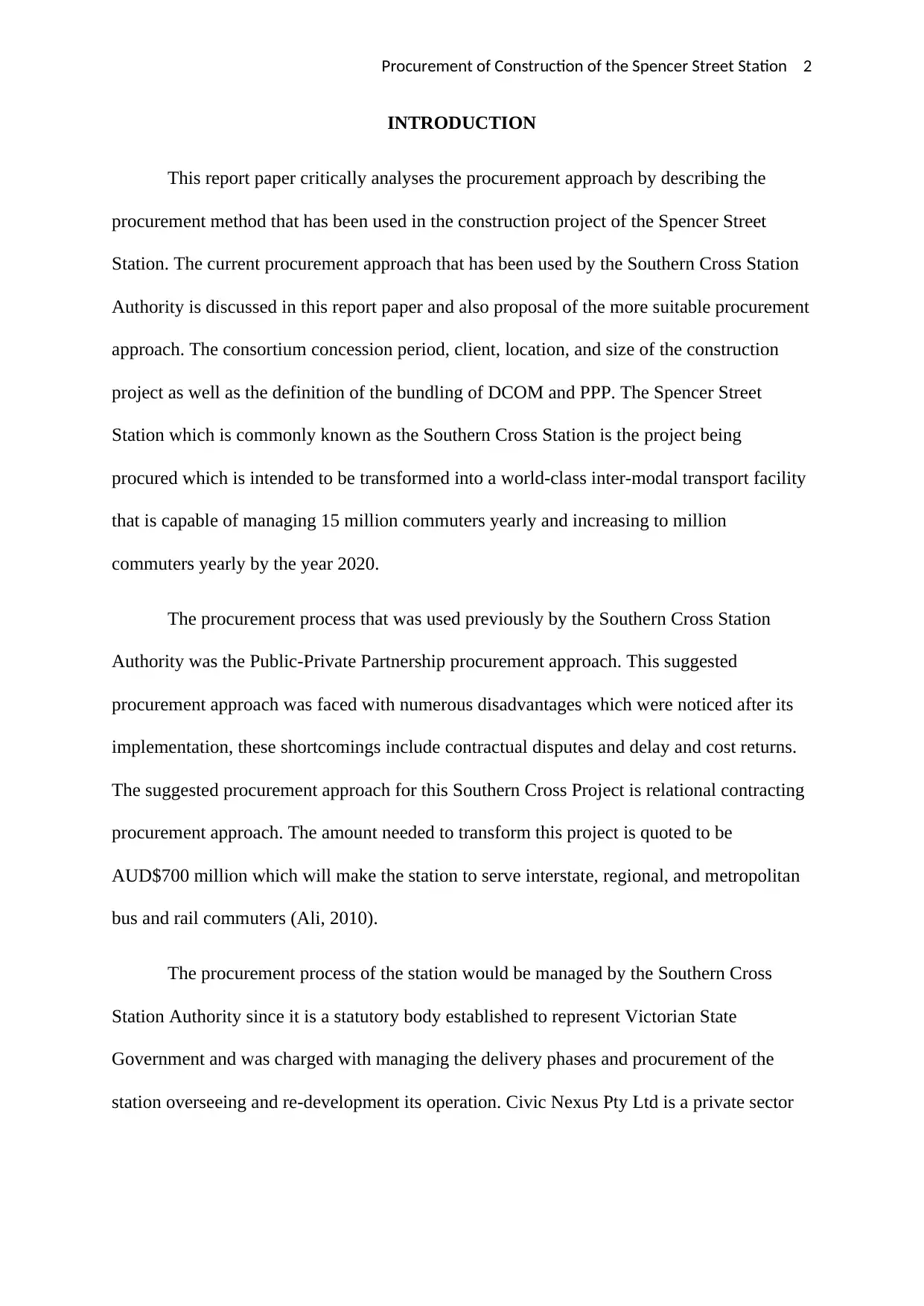
Procurement of Construction of the Spencer Street Station 2
INTRODUCTION
This report paper critically analyses the procurement approach by describing the
procurement method that has been used in the construction project of the Spencer Street
Station. The current procurement approach that has been used by the Southern Cross Station
Authority is discussed in this report paper and also proposal of the more suitable procurement
approach. The consortium concession period, client, location, and size of the construction
project as well as the definition of the bundling of DCOM and PPP. The Spencer Street
Station which is commonly known as the Southern Cross Station is the project being
procured which is intended to be transformed into a world-class inter-modal transport facility
that is capable of managing 15 million commuters yearly and increasing to million
commuters yearly by the year 2020.
The procurement process that was used previously by the Southern Cross Station
Authority was the Public-Private Partnership procurement approach. This suggested
procurement approach was faced with numerous disadvantages which were noticed after its
implementation, these shortcomings include contractual disputes and delay and cost returns.
The suggested procurement approach for this Southern Cross Project is relational contracting
procurement approach. The amount needed to transform this project is quoted to be
AUD$700 million which will make the station to serve interstate, regional, and metropolitan
bus and rail commuters (Ali, 2010).
The procurement process of the station would be managed by the Southern Cross
Station Authority since it is a statutory body established to represent Victorian State
Government and was charged with managing the delivery phases and procurement of the
station overseeing and re-development its operation. Civic Nexus Pty Ltd is a private sector
INTRODUCTION
This report paper critically analyses the procurement approach by describing the
procurement method that has been used in the construction project of the Spencer Street
Station. The current procurement approach that has been used by the Southern Cross Station
Authority is discussed in this report paper and also proposal of the more suitable procurement
approach. The consortium concession period, client, location, and size of the construction
project as well as the definition of the bundling of DCOM and PPP. The Spencer Street
Station which is commonly known as the Southern Cross Station is the project being
procured which is intended to be transformed into a world-class inter-modal transport facility
that is capable of managing 15 million commuters yearly and increasing to million
commuters yearly by the year 2020.
The procurement process that was used previously by the Southern Cross Station
Authority was the Public-Private Partnership procurement approach. This suggested
procurement approach was faced with numerous disadvantages which were noticed after its
implementation, these shortcomings include contractual disputes and delay and cost returns.
The suggested procurement approach for this Southern Cross Project is relational contracting
procurement approach. The amount needed to transform this project is quoted to be
AUD$700 million which will make the station to serve interstate, regional, and metropolitan
bus and rail commuters (Ali, 2010).
The procurement process of the station would be managed by the Southern Cross
Station Authority since it is a statutory body established to represent Victorian State
Government and was charged with managing the delivery phases and procurement of the
station overseeing and re-development its operation. Civic Nexus Pty Ltd is a private sector
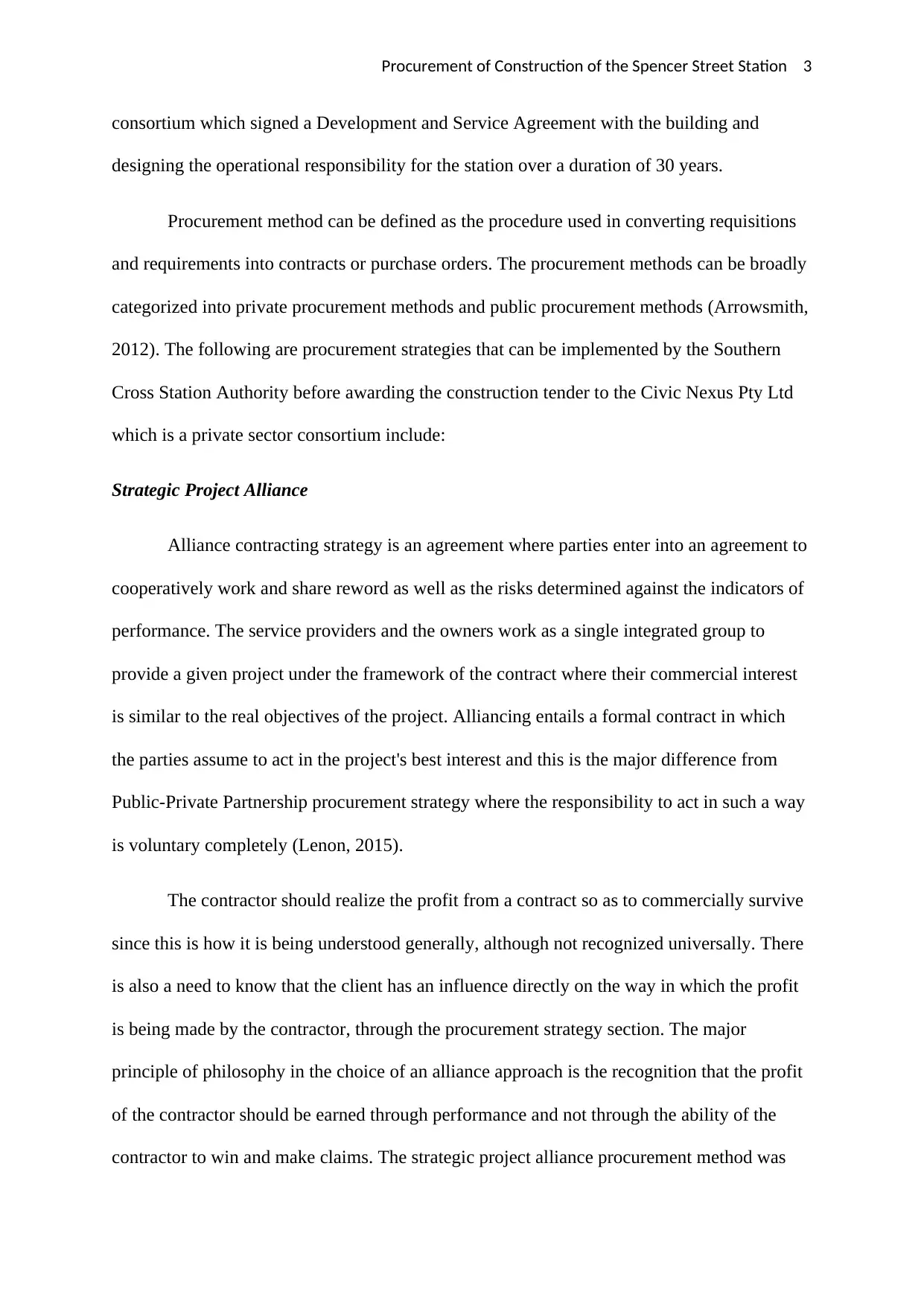
Procurement of Construction of the Spencer Street Station 3
consortium which signed a Development and Service Agreement with the building and
designing the operational responsibility for the station over a duration of 30 years.
Procurement method can be defined as the procedure used in converting requisitions
and requirements into contracts or purchase orders. The procurement methods can be broadly
categorized into private procurement methods and public procurement methods (Arrowsmith,
2012). The following are procurement strategies that can be implemented by the Southern
Cross Station Authority before awarding the construction tender to the Civic Nexus Pty Ltd
which is a private sector consortium include:
Strategic Project Alliance
Alliance contracting strategy is an agreement where parties enter into an agreement to
cooperatively work and share reword as well as the risks determined against the indicators of
performance. The service providers and the owners work as a single integrated group to
provide a given project under the framework of the contract where their commercial interest
is similar to the real objectives of the project. Alliancing entails a formal contract in which
the parties assume to act in the project's best interest and this is the major difference from
Public-Private Partnership procurement strategy where the responsibility to act in such a way
is voluntary completely (Lenon, 2015).
The contractor should realize the profit from a contract so as to commercially survive
since this is how it is being understood generally, although not recognized universally. There
is also a need to know that the client has an influence directly on the way in which the profit
is being made by the contractor, through the procurement strategy section. The major
principle of philosophy in the choice of an alliance approach is the recognition that the profit
of the contractor should be earned through performance and not through the ability of the
contractor to win and make claims. The strategic project alliance procurement method was
consortium which signed a Development and Service Agreement with the building and
designing the operational responsibility for the station over a duration of 30 years.
Procurement method can be defined as the procedure used in converting requisitions
and requirements into contracts or purchase orders. The procurement methods can be broadly
categorized into private procurement methods and public procurement methods (Arrowsmith,
2012). The following are procurement strategies that can be implemented by the Southern
Cross Station Authority before awarding the construction tender to the Civic Nexus Pty Ltd
which is a private sector consortium include:
Strategic Project Alliance
Alliance contracting strategy is an agreement where parties enter into an agreement to
cooperatively work and share reword as well as the risks determined against the indicators of
performance. The service providers and the owners work as a single integrated group to
provide a given project under the framework of the contract where their commercial interest
is similar to the real objectives of the project. Alliancing entails a formal contract in which
the parties assume to act in the project's best interest and this is the major difference from
Public-Private Partnership procurement strategy where the responsibility to act in such a way
is voluntary completely (Lenon, 2015).
The contractor should realize the profit from a contract so as to commercially survive
since this is how it is being understood generally, although not recognized universally. There
is also a need to know that the client has an influence directly on the way in which the profit
is being made by the contractor, through the procurement strategy section. The major
principle of philosophy in the choice of an alliance approach is the recognition that the profit
of the contractor should be earned through performance and not through the ability of the
contractor to win and make claims. The strategic project alliance procurement method was
⊘ This is a preview!⊘
Do you want full access?
Subscribe today to unlock all pages.

Trusted by 1+ million students worldwide
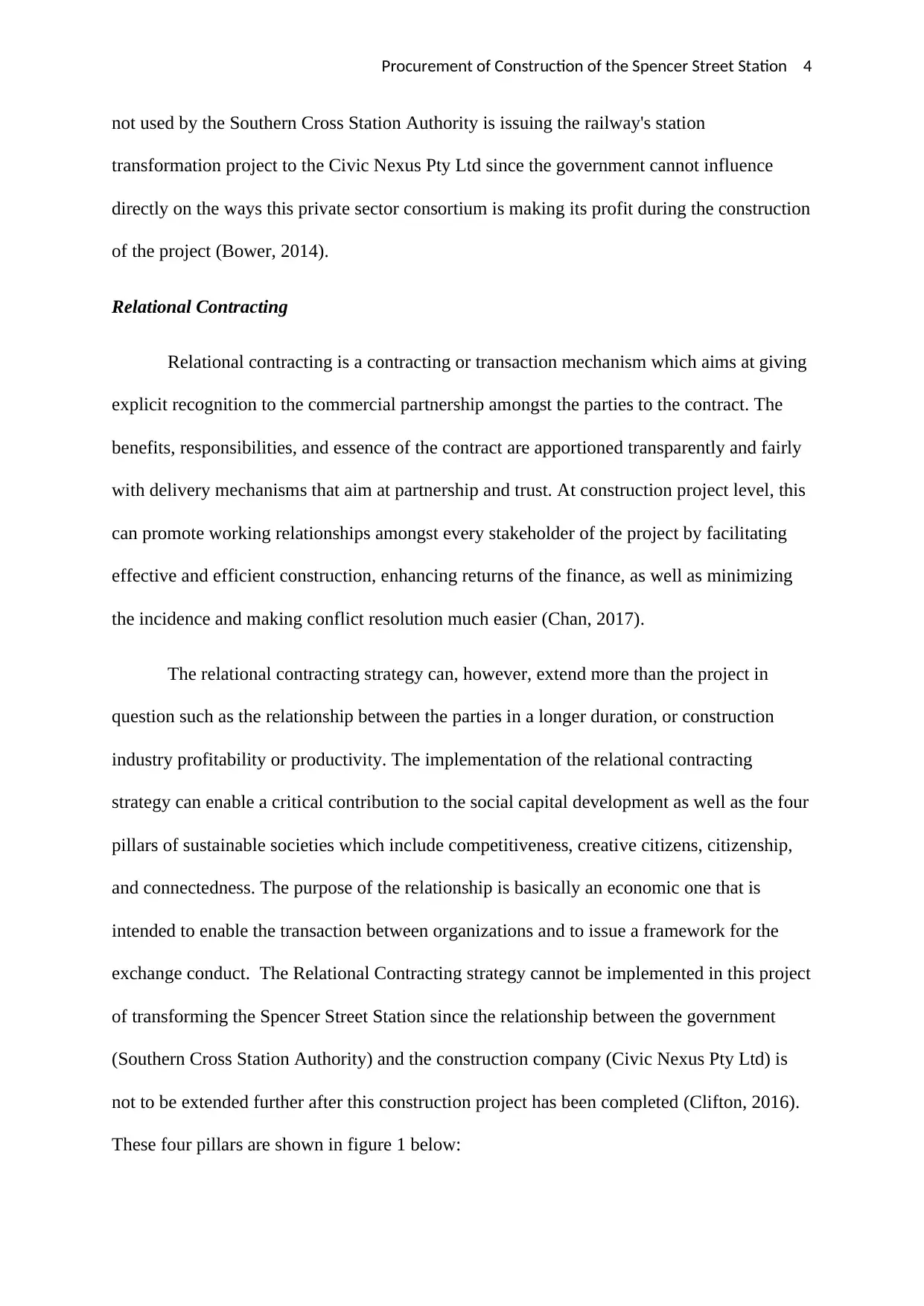
Procurement of Construction of the Spencer Street Station 4
not used by the Southern Cross Station Authority is issuing the railway's station
transformation project to the Civic Nexus Pty Ltd since the government cannot influence
directly on the ways this private sector consortium is making its profit during the construction
of the project (Bower, 2014).
Relational Contracting
Relational contracting is a contracting or transaction mechanism which aims at giving
explicit recognition to the commercial partnership amongst the parties to the contract. The
benefits, responsibilities, and essence of the contract are apportioned transparently and fairly
with delivery mechanisms that aim at partnership and trust. At construction project level, this
can promote working relationships amongst every stakeholder of the project by facilitating
effective and efficient construction, enhancing returns of the finance, as well as minimizing
the incidence and making conflict resolution much easier (Chan, 2017).
The relational contracting strategy can, however, extend more than the project in
question such as the relationship between the parties in a longer duration, or construction
industry profitability or productivity. The implementation of the relational contracting
strategy can enable a critical contribution to the social capital development as well as the four
pillars of sustainable societies which include competitiveness, creative citizens, citizenship,
and connectedness. The purpose of the relationship is basically an economic one that is
intended to enable the transaction between organizations and to issue a framework for the
exchange conduct. The Relational Contracting strategy cannot be implemented in this project
of transforming the Spencer Street Station since the relationship between the government
(Southern Cross Station Authority) and the construction company (Civic Nexus Pty Ltd) is
not to be extended further after this construction project has been completed (Clifton, 2016).
These four pillars are shown in figure 1 below:
not used by the Southern Cross Station Authority is issuing the railway's station
transformation project to the Civic Nexus Pty Ltd since the government cannot influence
directly on the ways this private sector consortium is making its profit during the construction
of the project (Bower, 2014).
Relational Contracting
Relational contracting is a contracting or transaction mechanism which aims at giving
explicit recognition to the commercial partnership amongst the parties to the contract. The
benefits, responsibilities, and essence of the contract are apportioned transparently and fairly
with delivery mechanisms that aim at partnership and trust. At construction project level, this
can promote working relationships amongst every stakeholder of the project by facilitating
effective and efficient construction, enhancing returns of the finance, as well as minimizing
the incidence and making conflict resolution much easier (Chan, 2017).
The relational contracting strategy can, however, extend more than the project in
question such as the relationship between the parties in a longer duration, or construction
industry profitability or productivity. The implementation of the relational contracting
strategy can enable a critical contribution to the social capital development as well as the four
pillars of sustainable societies which include competitiveness, creative citizens, citizenship,
and connectedness. The purpose of the relationship is basically an economic one that is
intended to enable the transaction between organizations and to issue a framework for the
exchange conduct. The Relational Contracting strategy cannot be implemented in this project
of transforming the Spencer Street Station since the relationship between the government
(Southern Cross Station Authority) and the construction company (Civic Nexus Pty Ltd) is
not to be extended further after this construction project has been completed (Clifton, 2016).
These four pillars are shown in figure 1 below:
Paraphrase This Document
Need a fresh take? Get an instant paraphrase of this document with our AI Paraphraser
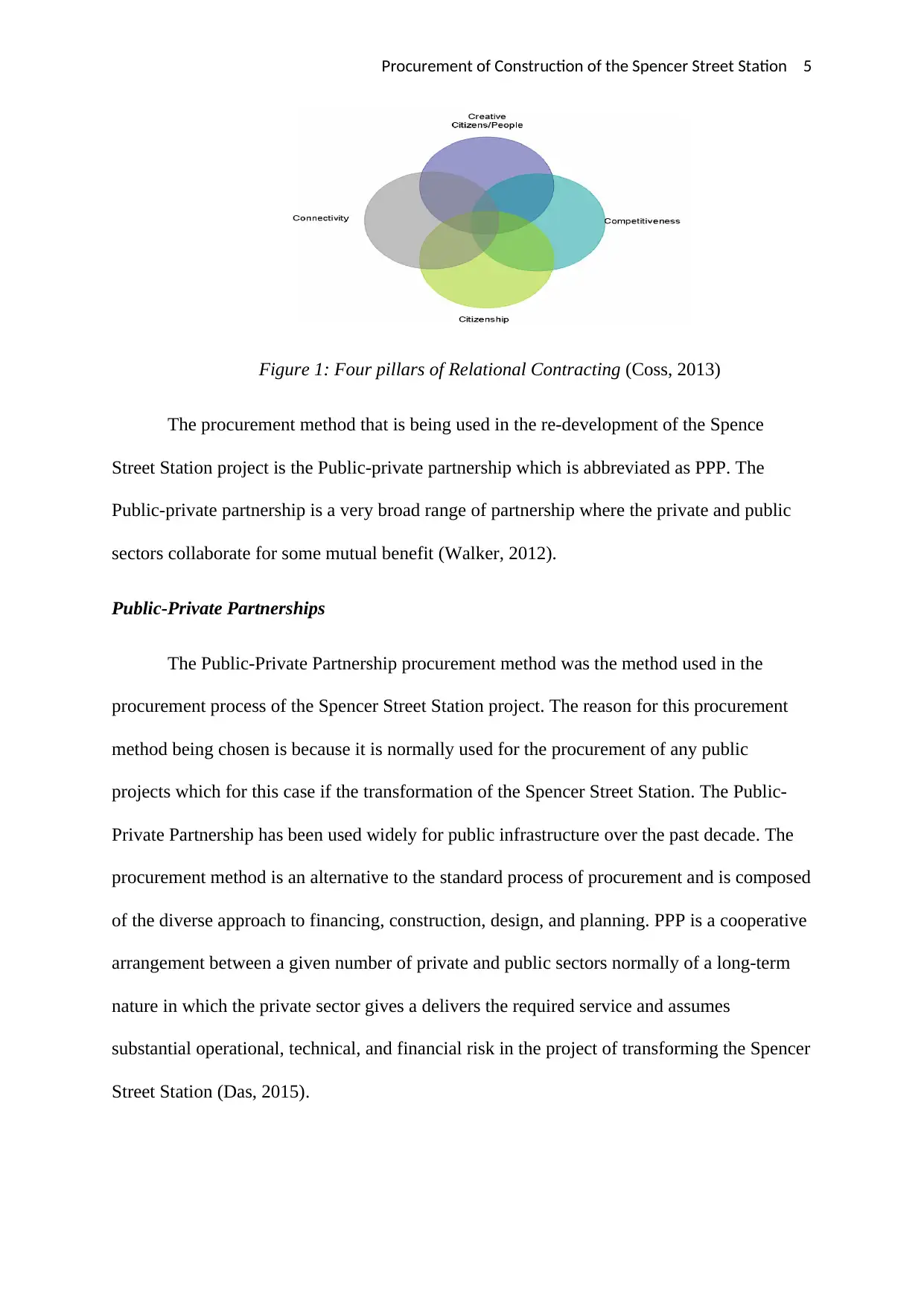
Procurement of Construction of the Spencer Street Station 5
Figure 1: Four pillars of Relational Contracting (Coss, 2013)
The procurement method that is being used in the re-development of the Spence
Street Station project is the Public-private partnership which is abbreviated as PPP. The
Public-private partnership is a very broad range of partnership where the private and public
sectors collaborate for some mutual benefit (Walker, 2012).
Public-Private Partnerships
The Public-Private Partnership procurement method was the method used in the
procurement process of the Spencer Street Station project. The reason for this procurement
method being chosen is because it is normally used for the procurement of any public
projects which for this case if the transformation of the Spencer Street Station. The Public-
Private Partnership has been used widely for public infrastructure over the past decade. The
procurement method is an alternative to the standard process of procurement and is composed
of the diverse approach to financing, construction, design, and planning. PPP is a cooperative
arrangement between a given number of private and public sectors normally of a long-term
nature in which the private sector gives a delivers the required service and assumes
substantial operational, technical, and financial risk in the project of transforming the Spencer
Street Station (Das, 2015).
Figure 1: Four pillars of Relational Contracting (Coss, 2013)
The procurement method that is being used in the re-development of the Spence
Street Station project is the Public-private partnership which is abbreviated as PPP. The
Public-private partnership is a very broad range of partnership where the private and public
sectors collaborate for some mutual benefit (Walker, 2012).
Public-Private Partnerships
The Public-Private Partnership procurement method was the method used in the
procurement process of the Spencer Street Station project. The reason for this procurement
method being chosen is because it is normally used for the procurement of any public
projects which for this case if the transformation of the Spencer Street Station. The Public-
Private Partnership has been used widely for public infrastructure over the past decade. The
procurement method is an alternative to the standard process of procurement and is composed
of the diverse approach to financing, construction, design, and planning. PPP is a cooperative
arrangement between a given number of private and public sectors normally of a long-term
nature in which the private sector gives a delivers the required service and assumes
substantial operational, technical, and financial risk in the project of transforming the Spencer
Street Station (Das, 2015).
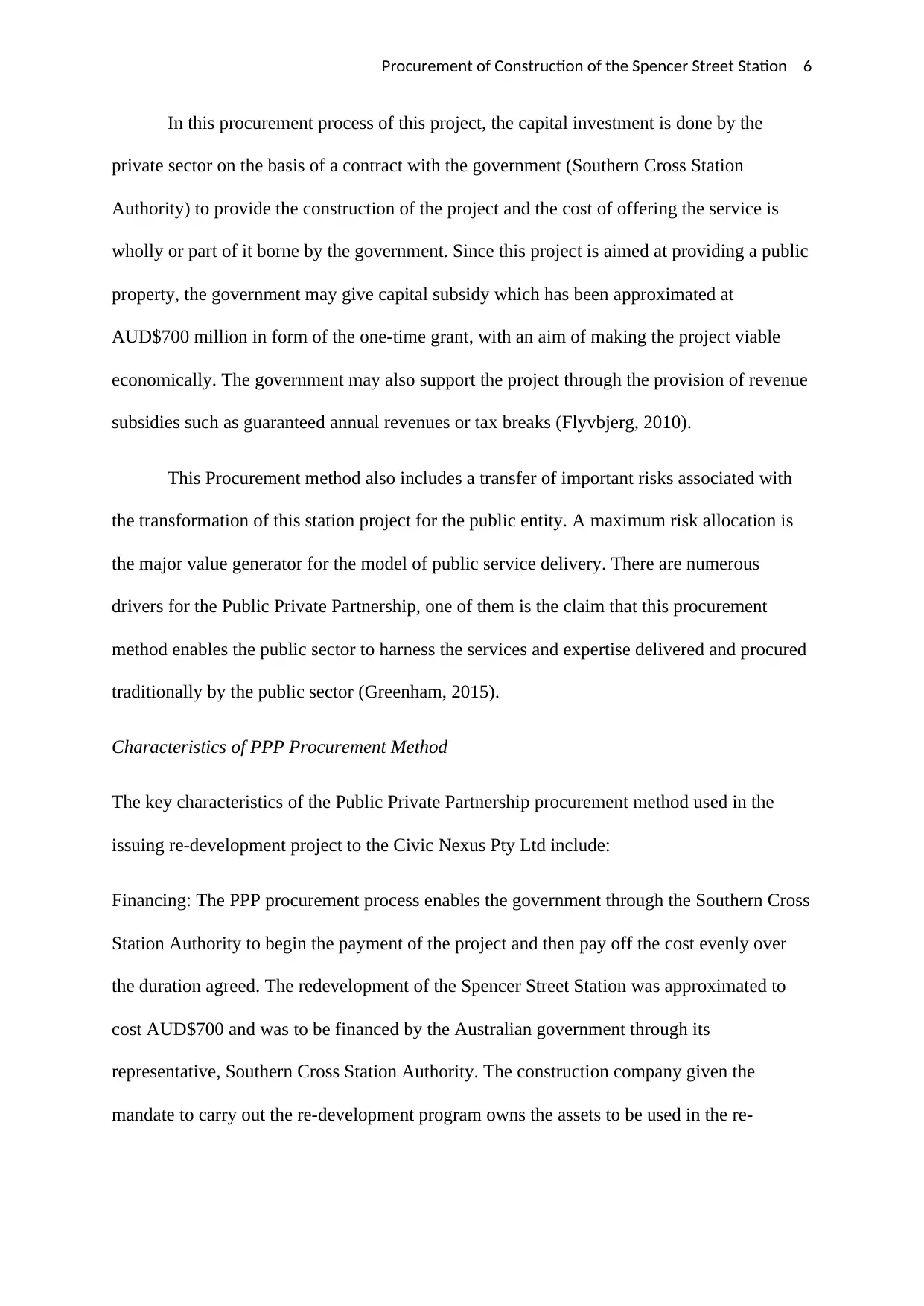
Procurement of Construction of the Spencer Street Station 6
In this procurement process of this project, the capital investment is done by the
private sector on the basis of a contract with the government (Southern Cross Station
Authority) to provide the construction of the project and the cost of offering the service is
wholly or part of it borne by the government. Since this project is aimed at providing a public
property, the government may give capital subsidy which has been approximated at
AUD$700 million in form of the one-time grant, with an aim of making the project viable
economically. The government may also support the project through the provision of revenue
subsidies such as guaranteed annual revenues or tax breaks (Flyvbjerg, 2010).
This Procurement method also includes a transfer of important risks associated with
the transformation of this station project for the public entity. A maximum risk allocation is
the major value generator for the model of public service delivery. There are numerous
drivers for the Public Private Partnership, one of them is the claim that this procurement
method enables the public sector to harness the services and expertise delivered and procured
traditionally by the public sector (Greenham, 2015).
Characteristics of PPP Procurement Method
The key characteristics of the Public Private Partnership procurement method used in the
issuing re-development project to the Civic Nexus Pty Ltd include:
Financing: The PPP procurement process enables the government through the Southern Cross
Station Authority to begin the payment of the project and then pay off the cost evenly over
the duration agreed. The redevelopment of the Spencer Street Station was approximated to
cost AUD$700 and was to be financed by the Australian government through its
representative, Southern Cross Station Authority. The construction company given the
mandate to carry out the re-development program owns the assets to be used in the re-
In this procurement process of this project, the capital investment is done by the
private sector on the basis of a contract with the government (Southern Cross Station
Authority) to provide the construction of the project and the cost of offering the service is
wholly or part of it borne by the government. Since this project is aimed at providing a public
property, the government may give capital subsidy which has been approximated at
AUD$700 million in form of the one-time grant, with an aim of making the project viable
economically. The government may also support the project through the provision of revenue
subsidies such as guaranteed annual revenues or tax breaks (Flyvbjerg, 2010).
This Procurement method also includes a transfer of important risks associated with
the transformation of this station project for the public entity. A maximum risk allocation is
the major value generator for the model of public service delivery. There are numerous
drivers for the Public Private Partnership, one of them is the claim that this procurement
method enables the public sector to harness the services and expertise delivered and procured
traditionally by the public sector (Greenham, 2015).
Characteristics of PPP Procurement Method
The key characteristics of the Public Private Partnership procurement method used in the
issuing re-development project to the Civic Nexus Pty Ltd include:
Financing: The PPP procurement process enables the government through the Southern Cross
Station Authority to begin the payment of the project and then pay off the cost evenly over
the duration agreed. The redevelopment of the Spencer Street Station was approximated to
cost AUD$700 and was to be financed by the Australian government through its
representative, Southern Cross Station Authority. The construction company given the
mandate to carry out the re-development program owns the assets to be used in the re-
⊘ This is a preview!⊘
Do you want full access?
Subscribe today to unlock all pages.

Trusted by 1+ million students worldwide
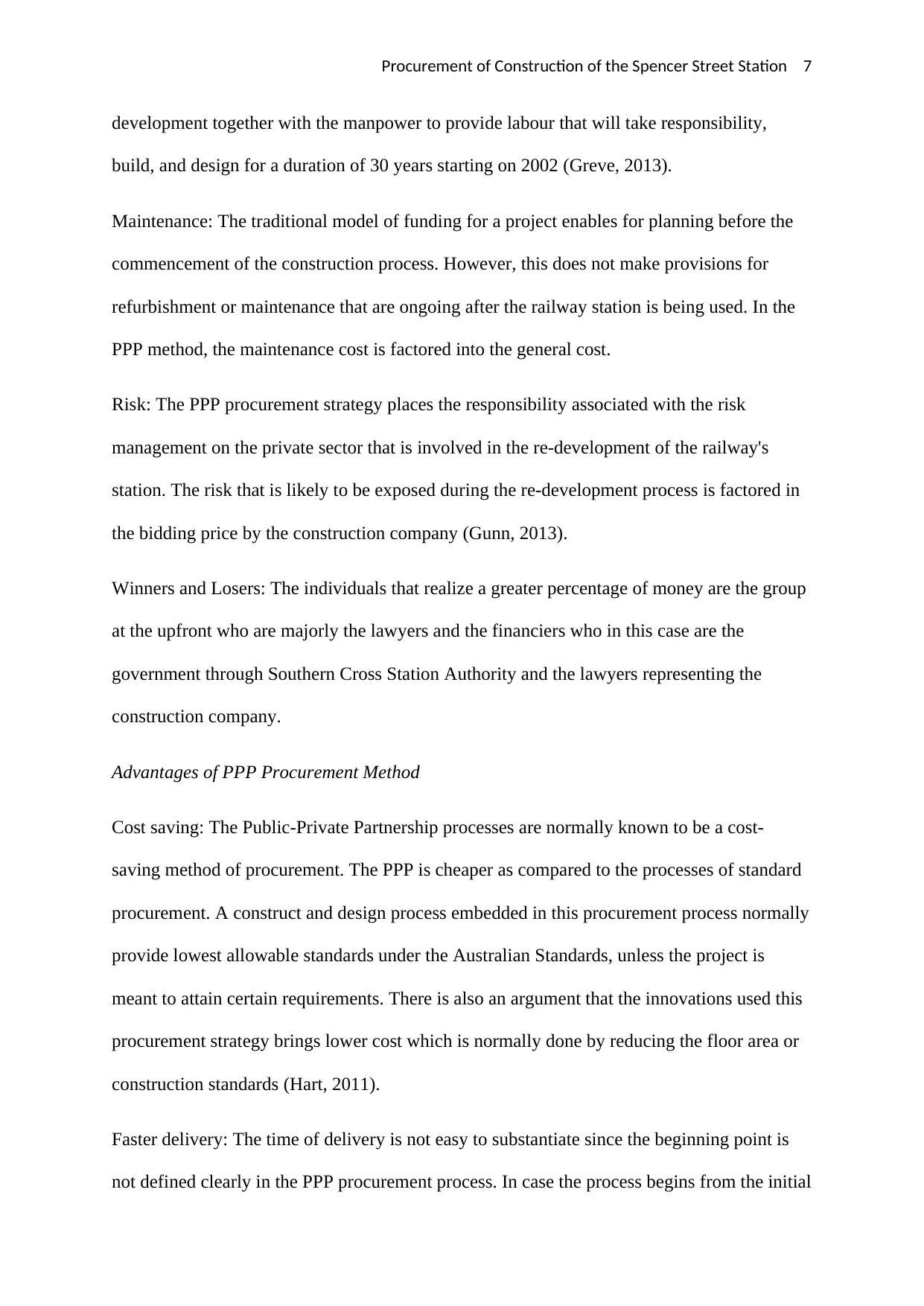
Procurement of Construction of the Spencer Street Station 7
development together with the manpower to provide labour that will take responsibility,
build, and design for a duration of 30 years starting on 2002 (Greve, 2013).
Maintenance: The traditional model of funding for a project enables for planning before the
commencement of the construction process. However, this does not make provisions for
refurbishment or maintenance that are ongoing after the railway station is being used. In the
PPP method, the maintenance cost is factored into the general cost.
Risk: The PPP procurement strategy places the responsibility associated with the risk
management on the private sector that is involved in the re-development of the railway's
station. The risk that is likely to be exposed during the re-development process is factored in
the bidding price by the construction company (Gunn, 2013).
Winners and Losers: The individuals that realize a greater percentage of money are the group
at the upfront who are majorly the lawyers and the financiers who in this case are the
government through Southern Cross Station Authority and the lawyers representing the
construction company.
Advantages of PPP Procurement Method
Cost saving: The Public-Private Partnership processes are normally known to be a cost-
saving method of procurement. The PPP is cheaper as compared to the processes of standard
procurement. A construct and design process embedded in this procurement process normally
provide lowest allowable standards under the Australian Standards, unless the project is
meant to attain certain requirements. There is also an argument that the innovations used this
procurement strategy brings lower cost which is normally done by reducing the floor area or
construction standards (Hart, 2011).
Faster delivery: The time of delivery is not easy to substantiate since the beginning point is
not defined clearly in the PPP procurement process. In case the process begins from the initial
development together with the manpower to provide labour that will take responsibility,
build, and design for a duration of 30 years starting on 2002 (Greve, 2013).
Maintenance: The traditional model of funding for a project enables for planning before the
commencement of the construction process. However, this does not make provisions for
refurbishment or maintenance that are ongoing after the railway station is being used. In the
PPP method, the maintenance cost is factored into the general cost.
Risk: The PPP procurement strategy places the responsibility associated with the risk
management on the private sector that is involved in the re-development of the railway's
station. The risk that is likely to be exposed during the re-development process is factored in
the bidding price by the construction company (Gunn, 2013).
Winners and Losers: The individuals that realize a greater percentage of money are the group
at the upfront who are majorly the lawyers and the financiers who in this case are the
government through Southern Cross Station Authority and the lawyers representing the
construction company.
Advantages of PPP Procurement Method
Cost saving: The Public-Private Partnership processes are normally known to be a cost-
saving method of procurement. The PPP is cheaper as compared to the processes of standard
procurement. A construct and design process embedded in this procurement process normally
provide lowest allowable standards under the Australian Standards, unless the project is
meant to attain certain requirements. There is also an argument that the innovations used this
procurement strategy brings lower cost which is normally done by reducing the floor area or
construction standards (Hart, 2011).
Faster delivery: The time of delivery is not easy to substantiate since the beginning point is
not defined clearly in the PPP procurement process. In case the process begins from the initial
Paraphrase This Document
Need a fresh take? Get an instant paraphrase of this document with our AI Paraphraser
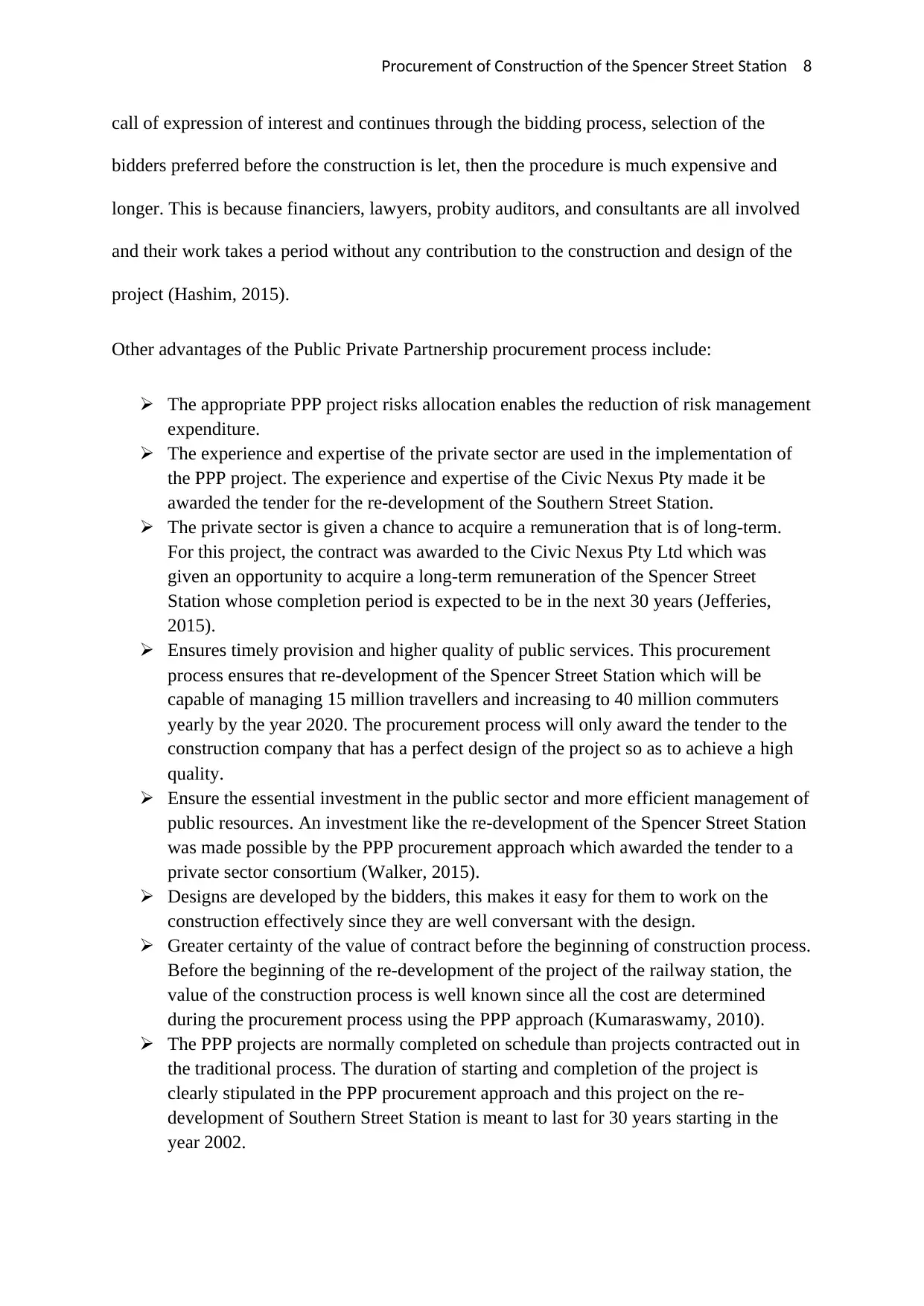
Procurement of Construction of the Spencer Street Station 8
call of expression of interest and continues through the bidding process, selection of the
bidders preferred before the construction is let, then the procedure is much expensive and
longer. This is because financiers, lawyers, probity auditors, and consultants are all involved
and their work takes a period without any contribution to the construction and design of the
project (Hashim, 2015).
Other advantages of the Public Private Partnership procurement process include:
The appropriate PPP project risks allocation enables the reduction of risk management
expenditure.
The experience and expertise of the private sector are used in the implementation of
the PPP project. The experience and expertise of the Civic Nexus Pty made it be
awarded the tender for the re-development of the Southern Street Station.
The private sector is given a chance to acquire a remuneration that is of long-term.
For this project, the contract was awarded to the Civic Nexus Pty Ltd which was
given an opportunity to acquire a long-term remuneration of the Spencer Street
Station whose completion period is expected to be in the next 30 years (Jefferies,
2015).
Ensures timely provision and higher quality of public services. This procurement
process ensures that re-development of the Spencer Street Station which will be
capable of managing 15 million travellers and increasing to 40 million commuters
yearly by the year 2020. The procurement process will only award the tender to the
construction company that has a perfect design of the project so as to achieve a high
quality.
Ensure the essential investment in the public sector and more efficient management of
public resources. An investment like the re-development of the Spencer Street Station
was made possible by the PPP procurement approach which awarded the tender to a
private sector consortium (Walker, 2015).
Designs are developed by the bidders, this makes it easy for them to work on the
construction effectively since they are well conversant with the design.
Greater certainty of the value of contract before the beginning of construction process.
Before the beginning of the re-development of the project of the railway station, the
value of the construction process is well known since all the cost are determined
during the procurement process using the PPP approach (Kumaraswamy, 2010).
The PPP projects are normally completed on schedule than projects contracted out in
the traditional process. The duration of starting and completion of the project is
clearly stipulated in the PPP procurement approach and this project on the re-
development of Southern Street Station is meant to last for 30 years starting in the
year 2002.
call of expression of interest and continues through the bidding process, selection of the
bidders preferred before the construction is let, then the procedure is much expensive and
longer. This is because financiers, lawyers, probity auditors, and consultants are all involved
and their work takes a period without any contribution to the construction and design of the
project (Hashim, 2015).
Other advantages of the Public Private Partnership procurement process include:
The appropriate PPP project risks allocation enables the reduction of risk management
expenditure.
The experience and expertise of the private sector are used in the implementation of
the PPP project. The experience and expertise of the Civic Nexus Pty made it be
awarded the tender for the re-development of the Southern Street Station.
The private sector is given a chance to acquire a remuneration that is of long-term.
For this project, the contract was awarded to the Civic Nexus Pty Ltd which was
given an opportunity to acquire a long-term remuneration of the Spencer Street
Station whose completion period is expected to be in the next 30 years (Jefferies,
2015).
Ensures timely provision and higher quality of public services. This procurement
process ensures that re-development of the Spencer Street Station which will be
capable of managing 15 million travellers and increasing to 40 million commuters
yearly by the year 2020. The procurement process will only award the tender to the
construction company that has a perfect design of the project so as to achieve a high
quality.
Ensure the essential investment in the public sector and more efficient management of
public resources. An investment like the re-development of the Spencer Street Station
was made possible by the PPP procurement approach which awarded the tender to a
private sector consortium (Walker, 2015).
Designs are developed by the bidders, this makes it easy for them to work on the
construction effectively since they are well conversant with the design.
Greater certainty of the value of contract before the beginning of construction process.
Before the beginning of the re-development of the project of the railway station, the
value of the construction process is well known since all the cost are determined
during the procurement process using the PPP approach (Kumaraswamy, 2010).
The PPP projects are normally completed on schedule than projects contracted out in
the traditional process. The duration of starting and completion of the project is
clearly stipulated in the PPP procurement approach and this project on the re-
development of Southern Street Station is meant to last for 30 years starting in the
year 2002.
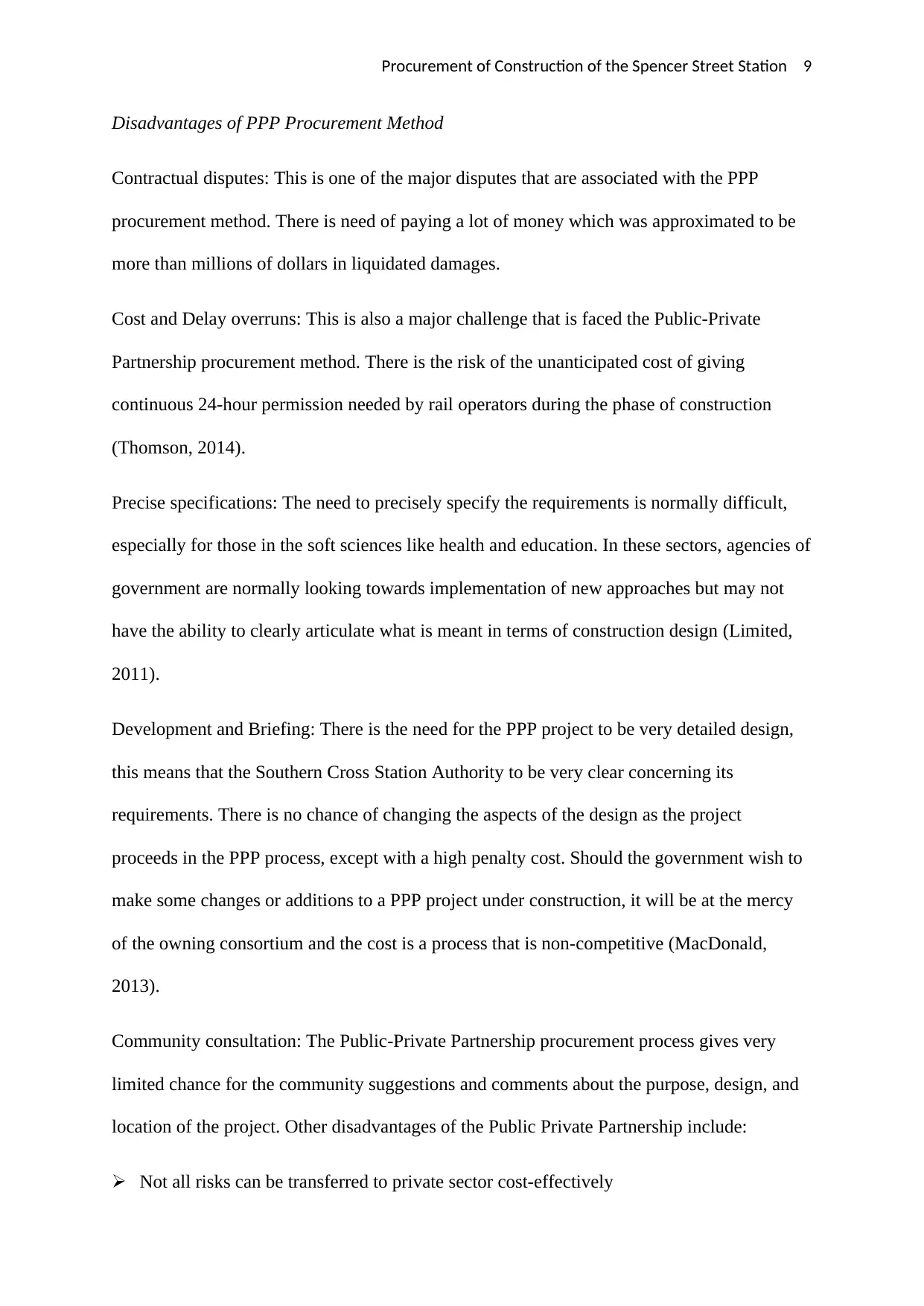
Procurement of Construction of the Spencer Street Station 9
Disadvantages of PPP Procurement Method
Contractual disputes: This is one of the major disputes that are associated with the PPP
procurement method. There is need of paying a lot of money which was approximated to be
more than millions of dollars in liquidated damages.
Cost and Delay overruns: This is also a major challenge that is faced the Public-Private
Partnership procurement method. There is the risk of the unanticipated cost of giving
continuous 24-hour permission needed by rail operators during the phase of construction
(Thomson, 2014).
Precise specifications: The need to precisely specify the requirements is normally difficult,
especially for those in the soft sciences like health and education. In these sectors, agencies of
government are normally looking towards implementation of new approaches but may not
have the ability to clearly articulate what is meant in terms of construction design (Limited,
2011).
Development and Briefing: There is the need for the PPP project to be very detailed design,
this means that the Southern Cross Station Authority to be very clear concerning its
requirements. There is no chance of changing the aspects of the design as the project
proceeds in the PPP process, except with a high penalty cost. Should the government wish to
make some changes or additions to a PPP project under construction, it will be at the mercy
of the owning consortium and the cost is a process that is non-competitive (MacDonald,
2013).
Community consultation: The Public-Private Partnership procurement process gives very
limited chance for the community suggestions and comments about the purpose, design, and
location of the project. Other disadvantages of the Public Private Partnership include:
Not all risks can be transferred to private sector cost-effectively
Disadvantages of PPP Procurement Method
Contractual disputes: This is one of the major disputes that are associated with the PPP
procurement method. There is need of paying a lot of money which was approximated to be
more than millions of dollars in liquidated damages.
Cost and Delay overruns: This is also a major challenge that is faced the Public-Private
Partnership procurement method. There is the risk of the unanticipated cost of giving
continuous 24-hour permission needed by rail operators during the phase of construction
(Thomson, 2014).
Precise specifications: The need to precisely specify the requirements is normally difficult,
especially for those in the soft sciences like health and education. In these sectors, agencies of
government are normally looking towards implementation of new approaches but may not
have the ability to clearly articulate what is meant in terms of construction design (Limited,
2011).
Development and Briefing: There is the need for the PPP project to be very detailed design,
this means that the Southern Cross Station Authority to be very clear concerning its
requirements. There is no chance of changing the aspects of the design as the project
proceeds in the PPP process, except with a high penalty cost. Should the government wish to
make some changes or additions to a PPP project under construction, it will be at the mercy
of the owning consortium and the cost is a process that is non-competitive (MacDonald,
2013).
Community consultation: The Public-Private Partnership procurement process gives very
limited chance for the community suggestions and comments about the purpose, design, and
location of the project. Other disadvantages of the Public Private Partnership include:
Not all risks can be transferred to private sector cost-effectively
⊘ This is a preview!⊘
Do you want full access?
Subscribe today to unlock all pages.

Trusted by 1+ million students worldwide
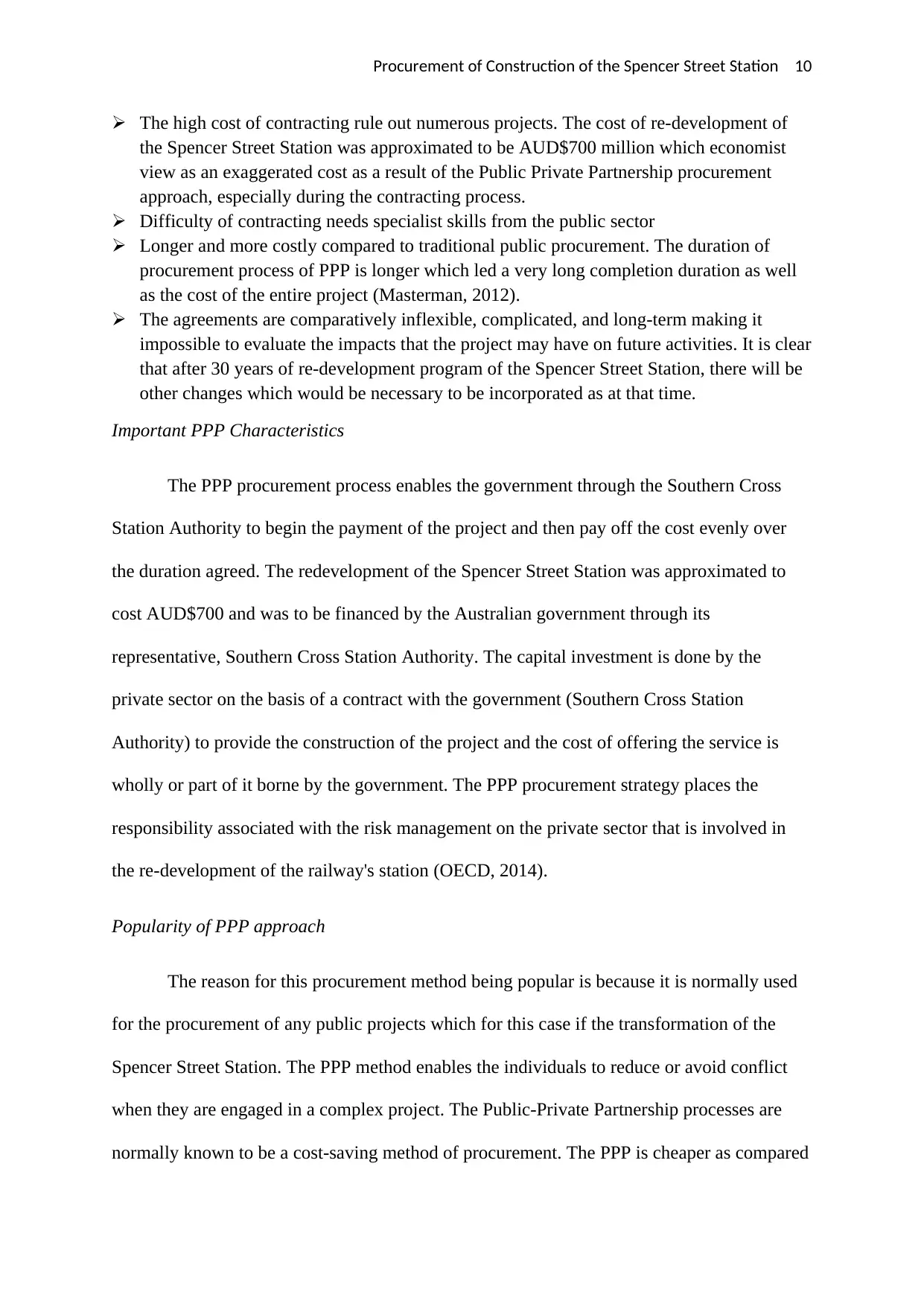
Procurement of Construction of the Spencer Street Station 10
The high cost of contracting rule out numerous projects. The cost of re-development of
the Spencer Street Station was approximated to be AUD$700 million which economist
view as an exaggerated cost as a result of the Public Private Partnership procurement
approach, especially during the contracting process.
Difficulty of contracting needs specialist skills from the public sector
Longer and more costly compared to traditional public procurement. The duration of
procurement process of PPP is longer which led a very long completion duration as well
as the cost of the entire project (Masterman, 2012).
The agreements are comparatively inflexible, complicated, and long-term making it
impossible to evaluate the impacts that the project may have on future activities. It is clear
that after 30 years of re-development program of the Spencer Street Station, there will be
other changes which would be necessary to be incorporated as at that time.
Important PPP Characteristics
The PPP procurement process enables the government through the Southern Cross
Station Authority to begin the payment of the project and then pay off the cost evenly over
the duration agreed. The redevelopment of the Spencer Street Station was approximated to
cost AUD$700 and was to be financed by the Australian government through its
representative, Southern Cross Station Authority. The capital investment is done by the
private sector on the basis of a contract with the government (Southern Cross Station
Authority) to provide the construction of the project and the cost of offering the service is
wholly or part of it borne by the government. The PPP procurement strategy places the
responsibility associated with the risk management on the private sector that is involved in
the re-development of the railway's station (OECD, 2014).
Popularity of PPP approach
The reason for this procurement method being popular is because it is normally used
for the procurement of any public projects which for this case if the transformation of the
Spencer Street Station. The PPP method enables the individuals to reduce or avoid conflict
when they are engaged in a complex project. The Public-Private Partnership processes are
normally known to be a cost-saving method of procurement. The PPP is cheaper as compared
The high cost of contracting rule out numerous projects. The cost of re-development of
the Spencer Street Station was approximated to be AUD$700 million which economist
view as an exaggerated cost as a result of the Public Private Partnership procurement
approach, especially during the contracting process.
Difficulty of contracting needs specialist skills from the public sector
Longer and more costly compared to traditional public procurement. The duration of
procurement process of PPP is longer which led a very long completion duration as well
as the cost of the entire project (Masterman, 2012).
The agreements are comparatively inflexible, complicated, and long-term making it
impossible to evaluate the impacts that the project may have on future activities. It is clear
that after 30 years of re-development program of the Spencer Street Station, there will be
other changes which would be necessary to be incorporated as at that time.
Important PPP Characteristics
The PPP procurement process enables the government through the Southern Cross
Station Authority to begin the payment of the project and then pay off the cost evenly over
the duration agreed. The redevelopment of the Spencer Street Station was approximated to
cost AUD$700 and was to be financed by the Australian government through its
representative, Southern Cross Station Authority. The capital investment is done by the
private sector on the basis of a contract with the government (Southern Cross Station
Authority) to provide the construction of the project and the cost of offering the service is
wholly or part of it borne by the government. The PPP procurement strategy places the
responsibility associated with the risk management on the private sector that is involved in
the re-development of the railway's station (OECD, 2014).
Popularity of PPP approach
The reason for this procurement method being popular is because it is normally used
for the procurement of any public projects which for this case if the transformation of the
Spencer Street Station. The PPP method enables the individuals to reduce or avoid conflict
when they are engaged in a complex project. The Public-Private Partnership processes are
normally known to be a cost-saving method of procurement. The PPP is cheaper as compared
Paraphrase This Document
Need a fresh take? Get an instant paraphrase of this document with our AI Paraphraser
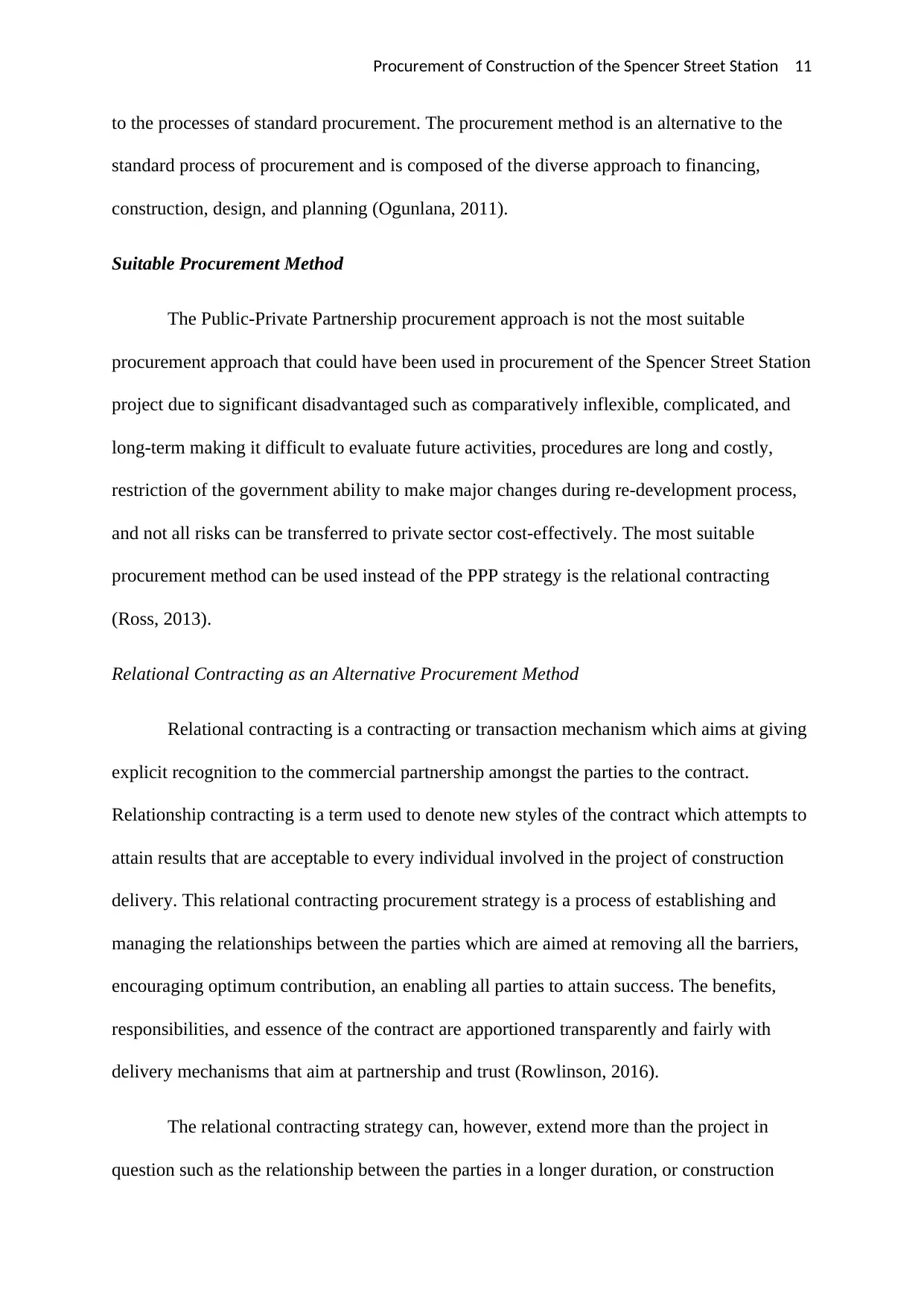
Procurement of Construction of the Spencer Street Station 11
to the processes of standard procurement. The procurement method is an alternative to the
standard process of procurement and is composed of the diverse approach to financing,
construction, design, and planning (Ogunlana, 2011).
Suitable Procurement Method
The Public-Private Partnership procurement approach is not the most suitable
procurement approach that could have been used in procurement of the Spencer Street Station
project due to significant disadvantaged such as comparatively inflexible, complicated, and
long-term making it difficult to evaluate future activities, procedures are long and costly,
restriction of the government ability to make major changes during re-development process,
and not all risks can be transferred to private sector cost-effectively. The most suitable
procurement method can be used instead of the PPP strategy is the relational contracting
(Ross, 2013).
Relational Contracting as an Alternative Procurement Method
Relational contracting is a contracting or transaction mechanism which aims at giving
explicit recognition to the commercial partnership amongst the parties to the contract.
Relationship contracting is a term used to denote new styles of the contract which attempts to
attain results that are acceptable to every individual involved in the project of construction
delivery. This relational contracting procurement strategy is a process of establishing and
managing the relationships between the parties which are aimed at removing all the barriers,
encouraging optimum contribution, an enabling all parties to attain success. The benefits,
responsibilities, and essence of the contract are apportioned transparently and fairly with
delivery mechanisms that aim at partnership and trust (Rowlinson, 2016).
The relational contracting strategy can, however, extend more than the project in
question such as the relationship between the parties in a longer duration, or construction
to the processes of standard procurement. The procurement method is an alternative to the
standard process of procurement and is composed of the diverse approach to financing,
construction, design, and planning (Ogunlana, 2011).
Suitable Procurement Method
The Public-Private Partnership procurement approach is not the most suitable
procurement approach that could have been used in procurement of the Spencer Street Station
project due to significant disadvantaged such as comparatively inflexible, complicated, and
long-term making it difficult to evaluate future activities, procedures are long and costly,
restriction of the government ability to make major changes during re-development process,
and not all risks can be transferred to private sector cost-effectively. The most suitable
procurement method can be used instead of the PPP strategy is the relational contracting
(Ross, 2013).
Relational Contracting as an Alternative Procurement Method
Relational contracting is a contracting or transaction mechanism which aims at giving
explicit recognition to the commercial partnership amongst the parties to the contract.
Relationship contracting is a term used to denote new styles of the contract which attempts to
attain results that are acceptable to every individual involved in the project of construction
delivery. This relational contracting procurement strategy is a process of establishing and
managing the relationships between the parties which are aimed at removing all the barriers,
encouraging optimum contribution, an enabling all parties to attain success. The benefits,
responsibilities, and essence of the contract are apportioned transparently and fairly with
delivery mechanisms that aim at partnership and trust (Rowlinson, 2016).
The relational contracting strategy can, however, extend more than the project in
question such as the relationship between the parties in a longer duration, or construction
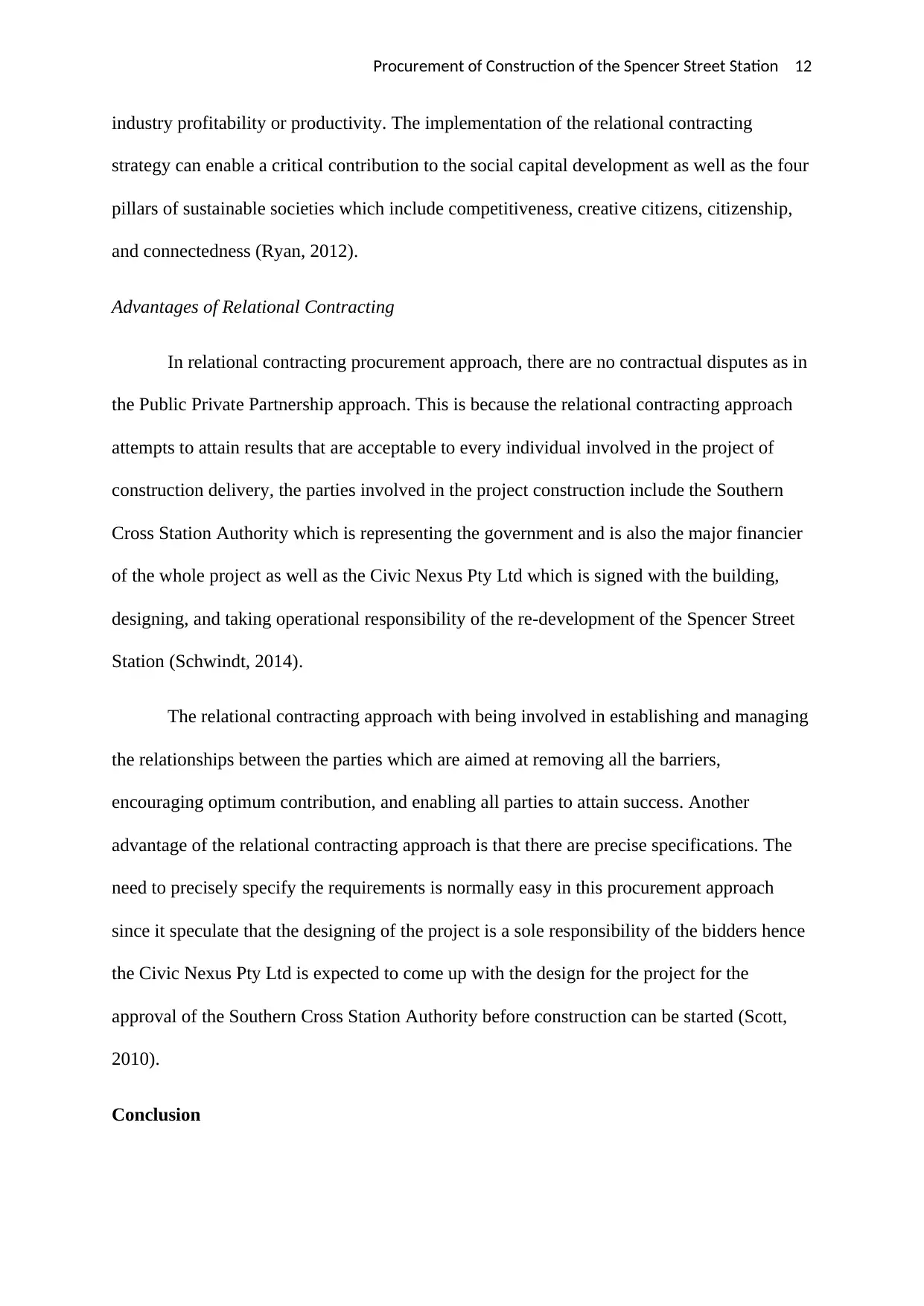
Procurement of Construction of the Spencer Street Station 12
industry profitability or productivity. The implementation of the relational contracting
strategy can enable a critical contribution to the social capital development as well as the four
pillars of sustainable societies which include competitiveness, creative citizens, citizenship,
and connectedness (Ryan, 2012).
Advantages of Relational Contracting
In relational contracting procurement approach, there are no contractual disputes as in
the Public Private Partnership approach. This is because the relational contracting approach
attempts to attain results that are acceptable to every individual involved in the project of
construction delivery, the parties involved in the project construction include the Southern
Cross Station Authority which is representing the government and is also the major financier
of the whole project as well as the Civic Nexus Pty Ltd which is signed with the building,
designing, and taking operational responsibility of the re-development of the Spencer Street
Station (Schwindt, 2014).
The relational contracting approach with being involved in establishing and managing
the relationships between the parties which are aimed at removing all the barriers,
encouraging optimum contribution, and enabling all parties to attain success. Another
advantage of the relational contracting approach is that there are precise specifications. The
need to precisely specify the requirements is normally easy in this procurement approach
since it speculate that the designing of the project is a sole responsibility of the bidders hence
the Civic Nexus Pty Ltd is expected to come up with the design for the project for the
approval of the Southern Cross Station Authority before construction can be started (Scott,
2010).
Conclusion
industry profitability or productivity. The implementation of the relational contracting
strategy can enable a critical contribution to the social capital development as well as the four
pillars of sustainable societies which include competitiveness, creative citizens, citizenship,
and connectedness (Ryan, 2012).
Advantages of Relational Contracting
In relational contracting procurement approach, there are no contractual disputes as in
the Public Private Partnership approach. This is because the relational contracting approach
attempts to attain results that are acceptable to every individual involved in the project of
construction delivery, the parties involved in the project construction include the Southern
Cross Station Authority which is representing the government and is also the major financier
of the whole project as well as the Civic Nexus Pty Ltd which is signed with the building,
designing, and taking operational responsibility of the re-development of the Spencer Street
Station (Schwindt, 2014).
The relational contracting approach with being involved in establishing and managing
the relationships between the parties which are aimed at removing all the barriers,
encouraging optimum contribution, and enabling all parties to attain success. Another
advantage of the relational contracting approach is that there are precise specifications. The
need to precisely specify the requirements is normally easy in this procurement approach
since it speculate that the designing of the project is a sole responsibility of the bidders hence
the Civic Nexus Pty Ltd is expected to come up with the design for the project for the
approval of the Southern Cross Station Authority before construction can be started (Scott,
2010).
Conclusion
⊘ This is a preview!⊘
Do you want full access?
Subscribe today to unlock all pages.

Trusted by 1+ million students worldwide
1 out of 15
Related Documents
Your All-in-One AI-Powered Toolkit for Academic Success.
+13062052269
info@desklib.com
Available 24*7 on WhatsApp / Email
![[object Object]](/_next/static/media/star-bottom.7253800d.svg)
Unlock your academic potential
Copyright © 2020–2025 A2Z Services. All Rights Reserved. Developed and managed by ZUCOL.



